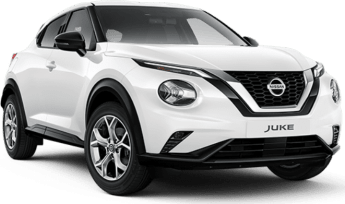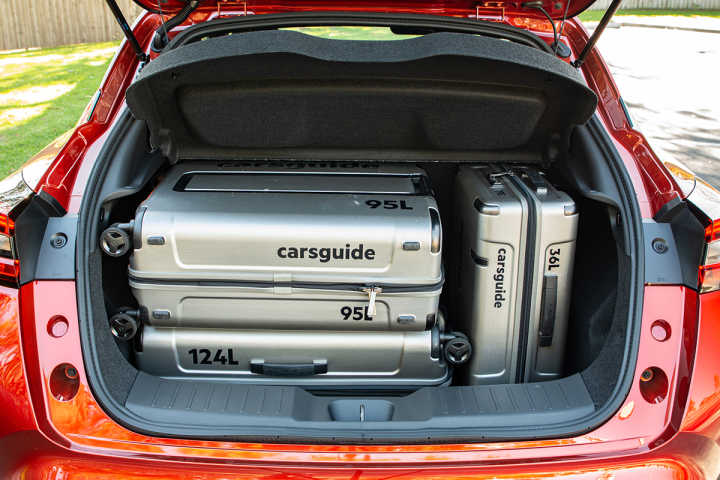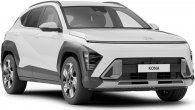I get asked this question frequently by concerned friends: Who is the target audience for the Nissan Juke?
I think the answer is a pretty easy one. This little SUV has always been about the way it looks over all other attributes. In the same way that people are willing to fork out hundreds of dollars for big-name sneakers that offer no tangible benefit over a $50 pair, the Juke is all about having something a little bit different from your neighbour.
In some ways, then, it’s the Tokyo street style alternative to many of its rivals. Unlike the first Juke, though, this new one has a few more edgy small SUV rivals on its hands, more of which are throwing around significant words like “hybrid” and “electric.”
So, can the conventionally unconventional Juke cut it in one of Australia’s most competitive and rapidly growing segments? I took a top-spec Ti for a week to find out.
Nissan Juke 2021: TI
| Engine Type | Turbo 3, 1.0L |
|---|---|
| Fuel Type | Premium Unleaded Petrol |
| Fuel Efficiency | 5.8L/100km (combined) |
| Seating | 5 |
| Price From | $23,650 - $29,150 |
| Safety Rating |
|
Does it represent good value for the price? What features does it come with?
The Ti is the top-spec Nissan Juke, and while it comes packed with a lot of gear, there are some areas where it misses out compared to rivals.
With an MSRP of $36,490, our Ti is the most expensive version, sticking it squarely against similarly sized rivals like the Toyota C-HR (from $35,165), Mazda CX-30 (G20 Touring - $35,190), and Hyundai Kona (N-Line $36,300).

I’ve drawn those rivals because not only are all three hugely popular and offering the kind of edgy styling the target buyer for the Juke will be looking for, but they also have one key advantage over the Juke, in that they can be chosen either as a mild hybrid, full hybrid, or electric.
Not having those options seems a dangerous flaw for a car that only arrived in Australia a year ago. There are other things, too. While the Juke’s specification covers off the main bases, for a top-spec variant there are tech areas where it is lacking compared to its rivals.
For example; while it locks in concept-car looks with huge 19-inch alloy wheels, LED headlights, and plush heated synthetic leather seats for the front passengers, there’s only an 8.0-inch multimedia touchscreen (some rivals will offer 10+ inch screens), no fully digital instrument cluster (even this car’s Renault Captur cousin gets one of these), no head-up display (Kona, CX-30), and no wireless charging.

Okay, so it’s a bit give and take with the spec, but I will say the Apple CarPlay connectivity, built-in navigation and tidy analog dash with a 4.2-inch TFT info screen between the dials worked seamlessly for me. Of particular note is the Bose sound system, which, even at low volumes, was superb and an unusual but perhaps fitting big-ticket selling point for an SUV that looks like this.
Privacy glass enhanced the black-on-orange tinge of our test car, as did the brightly coloured interior, which blends orange leather highlight pieces with matte silver and piano-black plastic highlights.

Elsewhere, the Ti gets single-zone climate control, heated front seats, keyless entry and push-start ignition, tyre-pressure monitoring, ambient interior lighting with illuminated kick plates, and a surround parking camera.
The Juke has been designed to look great and feel great, but is still missing not only electrified engine choices but some high-end tech, too.
Is there anything interesting about its design?
The Juke is all design, I’d say the look is perhaps its biggest selling point, but this time around form meets function, too.
The Juke is part of a new generation of eye-grabbing small SUVs that serve up a serious dollop of street style, for better or worse. This new car references the curvy, edgy lines that made the previous model loved and hated in equal measure, but does so with a confidently modern execution. LED lights and huge wheels combine with the subtly finished contrast panels to complete this car’s contemporary look.

I’d say it’s more of a balanced, well-rounded design than petrol versions of Hyundai’s recently updated Kona, for example. The Juke also offers an interesting alternative to the similar Toyota C-HR, which stops a little short of being quite this eye-grabbing.
Our Ti leaves me with the overall impression this car is essentially an automotive sneaker. Cool looks, a wide stance, and signature highlight points really set it apart, but perhaps above all the new burnt-orange paint glows in the light like few other colours, giving this Nissan a unique kerb appeal.
Inside is where the Juke easily pulls ahead of the C-HR, at least in my mind. Where the Toyota plays it mostly safe with familiar Corolla switchgear, the Juke goes full whacky with the orange synthetic leather dash-filler really off-setting the dark plastics and leathers and matte silver highlights. It’s a lot to take in, but it’s meant to be and is designed around wowing onlookers.

Again, it’s too bad the Juke doesn’t double down with an equally impressive tech package, as many rivals are now offering screens which measure in the double digits, and at this top-spec price point, a fully digital instrument cluster to match.
Instead, the Juke leans into its familiarity with other Nissan legends, with some subtle and not-so-subtle references to cars like the iconic R35 GT-R in its circular vent fittings and raised, leather-bound console elements.
Overall, the Juke’s design won’t be for everyone, but it leans so strongly into its street-cred element that those it does appeal to will be absolutely sold. If nothing else, the Juke is a signature for Nissan, standing the brand well apart from rivals on the road.
How practical is the space inside?
It's no secret that practicality was one of the worst elements of the previous-generation Juke. It had a tiny boot and back seat, next to no cabin storage, and woeful visibility.

The great improvement with this new one is its migration to a global platform it shares with Renault’s new Captur. This means all of these elements have been thought about from a wider perspective. Both cars need to look good and function just as well to give them the best chance of success, and I think both brands have really achieved it this time around.
It’s not without its issues, though. The Juke is still a bit light on the cabin storage up front, letting potential areas for storage bays give way to its overt design elements.
The centre console, for example, looks impressive with its raised shift-knob and synthetic leather cladding, compared to the previous Juke, but offers only a pair of cupholders and a tiny storage tray (which barely fit my iPhone 12) for stowing objects. There is also a truly tiny console armrest box, and some small storage bays in each door, but that’s it for front passengers.

Thankfully, unlike the previous Juke, the front seats are superb in quality and finish, an area which is becoming a Nissan strong point. The soft synthetic leather trim continues into the doors, and even the seating position and visibility are much improved this time around.
Rear passenger seating impressed me. While entry isn’t as easy as it is for front passengers, thanks to those small coupe-like doors, I was surprised to find I actually fit comfortably behind my own (182cm tall) driving position with a little room to spare for my knees.
The excellent seat trim continues (although it’s a little more flat and less supportive than the front), and even the rear doors come with a single large bottle holder and soft strips for your elbows. Amenity-wise, there’s a USB outlet for charging and a small tray on the back of the centre console, but no adjustable air vents. The small and heavily tinted windows also conspire with the abundance of dark trim and headliner to make the rear seat feel a bit claustrophobic and hard to see out of, despite decent head and leg room for adults.
Thanks to some smart design, the Juke also has a surprisingly large boot. Coming in at 422 litres (by no accident a figure identical to its Renault cousin) it’s big for the small SUV class and has a wide, open, and mostly square space, which fit our entire CarsGuide luggage set with relative ease, even with the cover in place. The only issue owners might run into here is the tall rear bumper, which might make loading heavy objects a chore. Under the floor the Juke has a space-saver spare wheel.
Overall, there’s a bit more to the Juke than just looks. This is now a small SUV, which can haul decent amounts of luggage and four adults with relative ease.
What are the key stats for the engine and transmission?
This is where the Juke starts to fall behind. Coming with this new look and globally focused underpinnings is a new 1.0-litre three-cylinder turbocharged petrol engine in a rather messy looking engine bay. It produces a very average 84kW/180Nm. This lands it on par with its 1.2-litre four-cylinder turbo C-HR rival, but crucially there’s no hybrid variant of any kind, which ultimately prevents it from getting near the front of the segment here.

It is mated to a seven-speed dual-clutch automatic transmission and drives the front wheels only.
For various reasons this combination has its good points and its bad points, which we’ll look at in the driving section, but one thing worth noting is the transmission has had a software update for the 2021 model year to improve some of its less-appealing characteristics.
How much fuel does it consume?
The Juke has a claimed/combined consumption figure of 5.8L/100km, courtesy of its small-capacity engine, placing it well amongst rivals.
Over a week of largely urban testing, our car returned a figure of 7.6L/100km, which is about right for this engine around town.
Because of its very European turbo engine, the Juke also requires mid-grade 95RON fuel. It may seem like this engine and transmission is offering up more than a few downsides, but it’s worth remembering this emissions-compliant combination will allow Nissan the economies of scale to sell this new-generation car in Europe.
Warranty & Safety Rating
What safety equipment is fitted? What safety rating?
At this top-spec Ti level the Juke comes fully loaded with the brand’s entire active-safety suite.

This includes freeway-speed auto emergency braking (capable of detecting pedestrians and cyclists), lane-departure warning with lane-keep assist, blind-spot monitoring, rear cross traffic alert, adaptive cruise control, and traffic-sign recognition.
The Juke has a particularly annoying lane-keep feature, which vibrates the steering wheel when you veer even slightly toward the edge of your lane, so this system spent most of my test week turned off.
The Juke comes with the standard array of electronic aids and six airbags, wearing a maximum five-star ANCAP safety rating to the 2019 standard, and scoring highly across all categories.
The outboard rear seats offer ISOFIX child-seat mounting points, while there are top-tether mounts across the whole rear row.
What does it cost to own? What warranty is offered?
The Juke is covered by Nissan’s class-standard five-year and unlimited-kilometre warranty, competitive with its key Toyota and Hyundai rivals, and offers a capped-price-servicing schedule.
This program is good considering this car’s complex drivetrain, with each 12 monthly or 20,000km service coming in with a yearly average cost of $382.67. Not bad compared to its rivals, and the long service interval is particularly welcome.
What's it like to drive around town?
The Juke certainly has its pros and cons here. I’m a fan of this car’s driving position; despite its design it offers fantastic visibility and ergonomic seating and steering adjustments. The functions, too, are controlled relatively easily, with dials for the key features and a multimedia screen, which is close and full of large touch elements on the stock software, making it easy to operate.

Unfortunately, and this is especially true around town, the Juke’s transmission is still annoying. It’s hesitant, jerky, and uneven to engage from a stop, and it particularly dislikes hills.
The software update recently rolled out has had some major benefits compared to when I first drove this car in 2020, with each progressive shift being smooth and effortless, instead of indecisive and slow, the opposite of what a dual clutch should be.
This improved shift-mapping pairs nicely with the turbocharged surge from the little engine to allow it to punch above its weight despite its low power figures, comparing well to the almost anaemic C-HR. While you’ll still have to overcome some turbo lag, I dare say this engine becomes fun when you’ve got a nice piece of road. It even trades out its ragged mechanical tone at low speeds for a more gruff and purposeful bark when you’ve got some revs going, adding to the experience.
The steering is fairly organic, light without being too much so, allowing the driver scope for some engagement with this car’s relatively refined chassis. There’s certainly fun to be had here, even if it has to be eked out on the right road and with a more aggressive driving style. Sport mode will even make the shifts snappier, but does nothing to arrest the shuddery launch behaviour.

The huge wheels do work with the firm suspension to make for a bit of a harsh ride, though, so it’s a far cry from the more comfortable cars in this segment, like the Toyota C-HR and Volkswagen T-Roc. Instead, the Juke deals poorly with more abrupt bumps and is noisy over road corrugations and textured surfaces, the likes of which are common in Australia’s population centres.
The drawbacks of this car just make it a little frustrating in an urban scenario. There’s a great car somewhere in here, with lots of admirable elements in the chassis, steering, ease of parking, and gruff little engine, but they’re not at the forefront, with the negative characteristics of the transmission, ride, and turbo-lag especially evident in the close-quarters of a city.
A hybrid option, which would alleviate many of the low-speed stresses this car is burdened with, can’t come soon enough.
Verdict
The Juke Ti is a tough one. There is a lot here that I was surprised and charmed by, even having reviewed the Juke before. This is a fun-looking, engaging little car, with a strong personality and surprising practicality.
It’s frustrating, however, that there are so many areas where even small improvements would turn a good car into a great one. The engine and transmission are at their worst in an urban scenario, and despite a unique and comfortable interior vibe and excellent Bose sound system, this car could really do with some of those high-end tech items like a digital dash, head-up display, and wireless charging to help it better appeal to a youthful urban buyer.
Pricing Guides











.jpg)
.jpg)
.jpg)







.png)








.jpg)

.jpg)

.jpg)
.jpg)

.jpg)

.jpg)
.jpg)

Comments